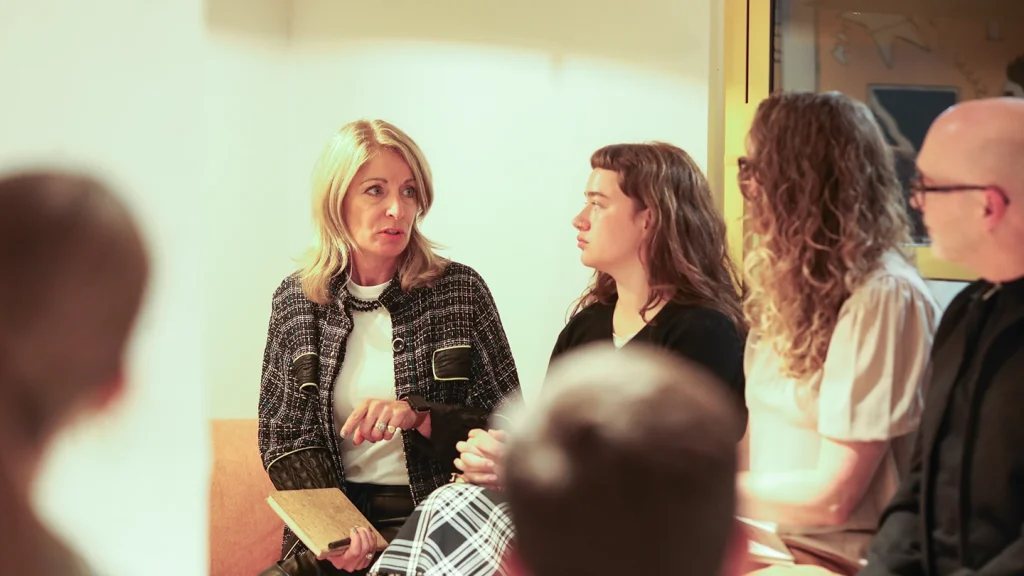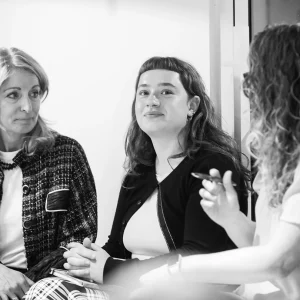
Education and practice have long moved in parallel, but rarely in sync. FX and Resonate Interiors brought together a panel drawn from all levels of the design education process to discuss how to redefine readiness for a profession facing new economic, social and creative pressures….
There is no shortage of creative talent emerging from design colleges and universities, but ensuring those ideas flourish in the workplace remains one of the industry’s biggest challenges. The latest design seminar on design education brought together voices from all areas of the process to discuss practical ways to strengthen connections, improve preparedness and value the fresh perspectives graduates bring. From the decline of design teaching in secondary schools to the need for mentoring, the discussion highlighted that getting the very best out of the next generation of designers does not just need opportunity, it requires genuine partnership.
The challenge for businesses is in trying to find the best raw recruits who can quickly get up to industry-level speed. Pernille Bonser, CEO at Resonate Interiors, said: ‘We interview a lot of graduates as well as a lot of mid-level and senior-level people. And I’d say with the graduates, sometimes their thoughts are very ethereal and it takes us a while to get them into the way of working. We love the creativity – it’s absolutely incredible and invaluable – but sometimes we need some of the basic knowledge for building regs because how buildings are actually put together is very important to us.
‘It varies depending on exactly which course the graduates have come from, but I would say sometimes we really need to work with our graduates for quite a few years to get them into a place where they can liaise with our clients and be a really strong benefit to the studio. Saying that, we love having the youngsters and we love their creativity.’
A member of Bonser’s team at Resonate, Anna Cridland, studied interior architecture at Oxford Brookes University and felt drawn towards a creative career. ‘I was actually inspired by my mum, my grandad and my dad,’ she explained. ‘My mum has always been artistic and, as a result, I learnt to do so many creative things as a young kid. She is an art and textiles teacher now and was a designer when I was younger. My dad is a planner and my grandad an engineer, so they come from a very different perspective and I think I just kind of went down the very middle of all of those disciplines.
‘I was always so interested in both the technical side and the creative side and I needed something that could incorporate both of those elements. Architecture and design is literally just that.’
What was the transition like from education to the world of work? Cridland said: ‘I actually had quite a smooth-sailing experience and I was offered a job straight away out of university. But that transition between first and second job, I would say, is also incredibly difficult because although I thought it was a bit of a blessing at first to be offered a job straight away, it meant that I never learned to job hunt in a serious environment. I didn’t learn skills to make portfolios and CVs, and I think that can be quite limiting because that wasn’t something that we were taught.’

Paul De’Ath, course leader of product design at Central Saint Martins, University of the Arts London, said that, for some, there can be a big perception gap between education and industry. ‘The expectations can be quite different,’ he explained. ‘There are similarities – strong similarities in fact – but ultimately, I do believe that, particularly with our graduates, they offer something far more than industry recognises. And having been on the industry side of it and responsible for recruiting and having seen so many CVs, at the time I didn’t perhaps appreciate the value that graduates can bring to a business.
‘The hard thing is how to let them know where their true value lies if they don’t have the experience to be able to position themselves. I think, in many ways, that is one of the biggest challenges.’
Julian Smith recently graduated from Bournemouth University having completed a degree in product design and is currently on the job hunt while working for his work placement company making bespoke kitchens. He chose the design route having been inspired by his dad’s involvement in house developing and his mum’s interest in art.
His journey into the world of product design excites him, but he admits that he has found plenty of challenges along the way in managing the transition into work. ‘I find applying for jobs quite difficult. When you’re “released” from education, it can be hard to motivate yourself and I have struggled sometimes, having to kick myself to apply for jobs,’ he said.

‘In particular, it’s tough when you see so many jobs for junior designer roles that ask for three years or more of experience. It makes you roll your eyes a bit, as it’s hard for graduates to be able to magically have experience of working and to fully understand how projects need to work when they are fresh out of education.’
Sam Bullen, head of technology faculty at Bungay High School in Suffolk, explained how his own route to the world of design was not necessarily, well, by design! ‘I didn’t choose it, I think it chose me,’ he said. ‘When I went to sixth form, my long-term goal was to move to Germany and to teach English in Germany. I did A-levels with that goal in mind and only picked product design because I needed to have a fourth option and I really had no idea what to pick.
‘My parents suggested that I chose something completely different to my other subjects. I picked product design and ended up absolutely loving the ability to design things and then realise them in a 3D outcome, which, for me, was not something that I had previously considered as a possibility let alone a career. It kind of snowballed from there really.’
As an educator at secondary school level, Bullen says there are a number of hurdles to overcome in linking the education process with the design workplace. ‘As a teacher, the challenges that we face can be around pupils’ misconceptions of what design and technology is at secondary school. Pupils come to us thinking they’re going to make stuff, and they enjoy making stuff. There are schools where pupils do make stuff but that idea of design and making do not always go hand in hand in secondary school. If you looked across the whole of the UK you would see a very broad spectrum of outcomes at both GCSE and at A-level, which then feeds into the university process. You would imagine things would be relatively standardised, but the differences mean you are going to have a whole plethora of outcomes and experiences, which then presents its own challenges.’

So how do universities help their students gain the kind of valuable experience of working in industry that employers so typically ask for? De’Ath said that incorporating work placements during studies brings value to the students: ‘We definitely see a significant improvement in the quality of the work when they come back for the final year. Invariably, within a three-year period a student can get experience in working alongside anything between one and four companies. So, although they may not be able to get three years’ experience, they will have a list of companies they have worked for.
‘I also feel quite strongly that that the “three years’ experience plus” job ads are actually a bit of an ambition rather than reality. Most of the jobs I’ve been aware of have quite often taken people with less experience if they have the right knowledge.
‘If they are going for a role which is very practical, there is a certain level of capability that goes with experience. But I think the reality is that if there is a point where having a variety of experiences is just as valuable as the total time. And that’s why we encourage both the Diploma in Professional Studies year to be taken, if it can be, but also we try to bring in a range of industry projects every year too.
‘We work with anything between five and 15 different industry collaborators who help the students to have some experience of what it’s like to work in industry. I think this makes it much easier for someone to go for a role with only six months’ experience but be confident enough that they can prove they are really capable. I think it helps to close the gap at least.’

Resonate’s Bonser was asked if her job ads ask for such experience. ‘No, I think this is largely recruiter speak. When an employer goes to a recruitment agency and the agency asks “do you want three years’ plus experience?”, you go “yes, why not”. In reality, I think rather than specific working experience, the most important thing is for people to bring their own experiences and their knowledge – everything they have learned during their studies basically.
‘I think working in industry, even for a short time, makes a massive difference. But we don’t particularly ask for a specific amount of time.’
Cridland had a year and a half of work under her belt before joining Resonate. ‘It was one of the things that worried me a lot actually, that I had only a year and a half under my belt where two or three years – a more rounded and substantial number – might have helped me quite a lot on paper. It is a worry because of the sense that a lot of the time employers might judge you on that rather than getting you to come in for an interview so you can actually have a chance to prove yourself.’
Julian Smith said that during his school days, he was undecided about his preferred career path but that a work placement during his university course helped him set his sights. ‘I think my placement helped a lot. I think it was the single best thing that came out of my university degree. I was lucky enough to just love going into work every day.
‘Working with kitchens made me lean towards interior-based product design. If I want to go into furniture design, I’m not sure if studying product design was the ideal route but really it’s about creating opportunities to feel a spark of enthusiasm or inspiration. If you find your niche, it helps you to focus on the right direction to go in.’
The panel considered the role of contacts and networking in bridging the gap between education and industry. De’Ath said: ‘When I was younger, I was really uncomfortable with putting myself out there, meeting people, having to engage people, but one of the most powerful things one can do is network. It’s just creating friends, future friends, an appreciation maybe of a topic that you care about, and those conversations make such a big difference to how students can move on and progress from their education. Their practical experience is one thing, but I think the most powerful thing that students can do is to just put themselves out there.’
There is sometimes a sense of students expecting opportunities to be handed to them as part of their university course. However, Smith said it is important for students to understand their own responsibilities in forging their own path: ‘I don’t think the onus is on the lecturers. I think at that point, I think once you’ve graduated from university, you are an adult. I think lecturers can do as much as they can to help during a student’s time there, but I don’t think there should be that much pressure on a lecturer once university has finished because they have spent three or four years of helping a student.’
Bullen added: ‘I do think the onus is also on the bigger practices to go to the universities and have those conversations. In a way, they’re the “grown-ups in the room”. Maybe they should go and approach the universities and colleges, asking to come in and talk about these amazing careers in architecture, design or product design. They should make those initial contacts and then, within that environment, it would be down to the students to be brave enough to then network themselves, take that opportunity, and go and meet these people.’
There were plenty of suggestions on how to improve connections between schools, universities and industry. These included encouragement of industry professionals visiting schools and universities to share experiences, organising studio visits for students, creating platforms for industry-education collaboration, and encouraging alumni to mentor current students.
Ultimately, securing connections of all kinds can be invaluable to students. Bullen said: ‘Contacts can be everything. What young people need is for people who work in the industry and live it and breathe it to come in and share not only their experience, but actually their passion for the subject and for the topic as well.
‘From a secondary school’s perspective, where do I go to find those people who are willing to give up a day, or to give up half a day even, to come out and share their passion and their knowledge and their experience and their creativity with young people who desperately need that? Because they might not have the role models, and they might feel like a little fish in a big pond, and they’re looking for as many opportunities for guidance, for people they can relate to.
‘If we, as educators, are not able to provide them with these contacts, then they really are going to miss out, and it’s a missed opportunity for both education but also industry as well. That’s definitely a big link that both elements can come together on somehow and work towards.’
He adds that it’s by no means easy to deliver the kind of fully-fledged contacts that students perhaps wish for – or expect: ‘The real-world opportunity is something that pupils respond really well to but something that schools find really challenging to instigate and to deliver. Probably less so at university level but certainly even at A-level, that link to industry is missing.
‘A lot of teachers have only ever taught and so they don’t always have those industry links that young people not only want but need as part of their experience of education. The earlier we can expose them to that and the earlier we can provide them with those opportunities, the easier their pathway through education will be for them.’
Cridland suggested that some students may be put off from pursuing a career in design due to the stigma around creative and design jobs from some quarters. ‘One of my lecturers made it seem quite daunting, suggesting that the atmosphere in architecture is horrible and that everyone is mean.
‘I remember actually starting my job and thinking ‘oh, this isn’t so bad’. It worked in my favour in the end because I had to overcome the fear of what the industry might be like, only to discover it is a really nice sector to work in. However, some were put off by how it was painted and decided it didn’t sound like the sort of career route for them, which is such a shame.’
The panel discussed the often understated ‘creative attributes’; skills like connectivity, communication, resilience, and storytelling that are valuable in design and industry, helping individuals adapt and perform beyond technical knowledge.
Bullen said: ‘From the minute they come in at 11 years old, we talk to pupils about employability skills because ultimately young people go through education expecting some form of employability skill to come at the end of it. And so the earlier we can start talking to them about that, the better. These are what we call the softer skills; things like conceptualisation, teamwork – those terms that are so critical to being successful in industry. If we can get them recognising those and what that might look like within any subject within school, we stand a better chance of them being able to be more successful when they then move on to whatever that next step may be, whether it is further education or whether it is employment or training.’
So, what final thoughts did participants share about bridging the education-industry gap? There was general agreement about the need for stronger links between education and industry, better preparation for students transitioning to work, more industry engagement in education, and recognition of the value graduates bring to businesses.
Smith felt that some extra careers advice in the final year of university study would be beneficial: ‘It would be ideal if there was a bit more of a guide as to what you do after uni when you get close to the end of the process, because you get taught all these things but are then kind of let loose into the working world. That can be a bit overwhelming at the start.
‘There could be a little more engagement from careers advisors as students sometimes need a little bit more of a kick to focus on some of these extra skills they need when applying for jobs and succeeding at interviews, for example.’
Resonate’s Cridland said: ‘I think the big issue is that we are constantly fighting the stigma that creative and design jobs are not serious enough and are a bit of a waste of time. The underfunding of those subjects in secondary education really legitimises that stigma on it and I think that’s where the first crack comes.
‘If we taught creative and art-based subjects as if they were as important as science and maths – because art is important – it would reflect what is an incredibly large portion of our economy and put an end to these disciplines being constantly undervalued.’
Bullen said: ‘Certainly from a secondary school’s perspective, there is an absolute desire for there to be a stronger link between education and industry. How that is established, how it manifests itself, I don’t know. But from my position as a teacher, it would make my job inevitably easier – and students would get a lot out of it.
‘Industry would also benefit hugely too. Quite what form it takes and how it manifests itself is unclear, but there is an absolute need for it if we want to continue to inspire, nurture, develop the next generation of designers in industry. It’s an absolute must.’





